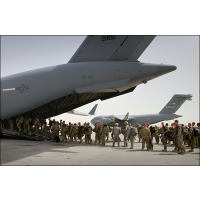Military Spending Down in U.S.; Up in Middle East, Asia and Africa
 U.S. soldiers board aircraft to leave Afghanistan (photo: Musadeq Sadeq, AP)
U.S. soldiers board aircraft to leave Afghanistan (photo: Musadeq Sadeq, AP)
Government expenditures on the military went down worldwide last year, in large part because the U.S. for a change spent less on the armed forces. But the overall drop in military spending belies the fact that countries in Asia, Africa and the Middle East ramped up their allocations—in some cases quite considerably—on warfare.
Across the globe last year, military spending dropped 1.9% compared to 2012, consuming $1.75 trillion, according to the Stockholm International Peace Research Institute (SIPRI).
Western nations cut back on the military, particularly the U.S. due to its scheduled withdrawal from Afghanistan, the end of the Iraq war, and budget cuts ordered by Congress. America’s dip amounted to 7.8%.
But outside the U.S., military spending internationally increased by 1.8%.
In some regions, like Africa, it really shot up. The continent as a whole witnessed an 8.3% jump in 2013, totaling nearly $45 billion.
Algeria led the way and became the first country in Africa to eclipse the $10 billion mark in military spending. The government has devoted a far larger share of its revenue to bolstering the army since 2004, with military expenditures rising 176% since then.
Other big spenders in Africa included Angola (a 36% increase), which now devotes more to the military than any other nation in sub-Saharan Africa, including South Africa.
SIPRI says oil revenues are the biggest reason for Algeria’s and Angola’s military spending increases.
Defense spending in the Middle East rose 4% in 2013, to $150 billion. Saudi Arabia’s share expanded by 14% (totaling $67 billion), making it now the fourth largest spender in the world, following the U.S., China and Russia. But the largest percentage increases were in Iraq (27%) and Bahrain (26%).
In Asia, China was again the dominant power among military budgets. Beijing bumped its expenditures by 7.4% for a total of $188 billion. Military spending throughout Asia and Oceania totaled $407 billion.
The largest percentage increase in the region belonged to Afghanistan (77%), which has been working to bolster its security forces in preparation for the U.S. pullout.
There are a variety of reasons for the increase in military spending in emerging and developing countries, according to Dr. Sam Perlo-Freeman, the director of SIPRI’s Military Expenditure Project. “While in some cases it is the natural result of economic growth or a response to genuine security needs, in other cases it represents a squandering of natural resource revenues, the dominance of autocratic regimes, or emerging regional arms races,” he said in a press statement.
-Noel Brinkerhoff
To Learn More:
Military Spending Continues to Fall in the West But Rises Everywhere Else, Says SIPRI (Stockholm International Peace Research Institute)
Trends in World Military Expenditure, 2013 (by Sam Perlo-Freeman and Carina Solmirano)
U.S. Spends $1 Trillion a Year on Defense and Security (by Noel Brinkerhoff, AllGov)
U.S. Spends 6 Times More on Military than Any Other Country (by Noel Brinkerhoff and David Wallechinsky, AllGov)
- Top Stories
- Unusual News
- Where is the Money Going?
- Controversies
- U.S. and the World
- Appointments and Resignations
- Latest News
- Trump to Stop Deportations If…
- Trump Denounces World Series
- What If China Invaded the United States?
- Donald Trump Has a Mental Health Problem and It Has a Name
- Trump Goes on Renaming Frenzy






Comments